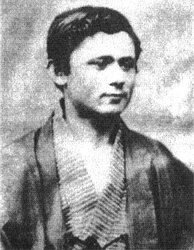Michael Moser (photographer)
Michael Moser (born May 3, 1853 ; † November 24, 1912 in Bad Aussee ) was an Austrian photographer .
Originally from Altaussee , Moser spent - unusual for his time - a few years in Japan , where he took numerous pictures of the country and its people.
biography
Michael Moser was born to Joachim and Eva Moser. The father worked in the salt mine and worked as a wood carver to increase the family income. That is why the Viennese photographer Wilhelm Burger , who took landscape photos in Altaussee and needed a wooden frame for his camera, was referred to Moser, where he also met the young Michael. Pleased by his hard work and enthusiasm, he took the 14-year-old to Vienna as an apprentice photographer in 1867 . When Burger was then appointed as the expedition photographer for the KK mission to East Asia in 1868, which had the aim of concluding trade and shipping contracts, he took Moser with him as an assistant.
On October 18, 1868, the frigate “Danube” and the screw corvette “Archduke Friedrich” set sail from Trieste . The journey went through Ragusa , Messina , Algiers , Gibraltar , Tangier and Tenerife ; on December 20th one passed the equator . The ships arrived in Cape Town on January 26th , where they stayed for 23 days. The onward journey took place via Java and Singapore to Bangkok , where the expedition stayed for almost a month and was admitted to an audience with the King of Siam , who also visited the "Danube" with his entourage.
From Bangkok the voyage went to Saigon , Hong Kong and Shanghai , from where the ships left for Japan on August 31 and landed in Yokohama on October 2 . When the two ships started their return voyage on November 14, 1869, Michael Moser stayed in Japan. The prospect of only finding work in the salt mine in Altaussee and his great susceptibility to seasickness during the long voyages reinforced his decision.
In Japan, Moser initially stayed afloat as a waiter's lad in a Russian harbor bar, then a guest from France suggested that they set up a photo studio together. When it was destroyed in a typhoon, Moser turned to Mr. Black, editor of the illustrated monthly “Japan Gazette / Far East”. He took care of him and Moser began to travel around Japan, taking pictures of the country and its people and acquiring language skills. In an astonishingly short time he learned perfect written and spoken Japanese, English, Italian and some French.
When the Japanese government decided to take part in the Vienna World Exhibition in 1873, Michael Moser was appointed as an interpreter . The delegation headed by Sano Tsunetami , the first Japanese envoy in Vienna, arrived at the end of March and in June of that year Moser was given the opportunity to visit his family in Altaussee for a few days. After the end of the world exhibition, Moser traveled to Venice , where he learned the technique of "moonlight photography" from the photographer Carl Naya . After another short stay in his hometown, he returned to Japan.
There Moser was employed as a photographer in government services and was able to settle in the foreign quarter of Edo , today's Tokyo . Through Sano Tsunetami, he was also given the great honor of being introduced to the imperial couple. In 1876 he traveled with a Japanese delegation to Philadelphia , where in turn his talents as an interpreter for the Centennial Exhibition were used. There, however, Moser fell ill with typhoid nerve fever and after a long hospital stay he decided to return to his homeland.
On February 1, 1877, he arrived in Altaussee, where he and his brother Eusebius opened a photo studio in their parents' house. In one room of the house he set up a “Japanese cabinet” with the art objects brought from Japan. In 1878 Moser worked again for the Japanese government and worked as an interpreter at the Paris World Exhibition .
In 1880 he finally set up a studio in Bad Aussee and received the Silver State Prize for his photographic work. Recognition diplomas from the KK Museum in Vienna (1881) and at the state exhibition in Graz (1890) followed. In 1889 he married Franziska Fruhwirth, and their only son Philipp was born one year later. In addition to his photographic work, Moser was also active as a member of the spa commission. Michael Moser died on November 24, 1912 at the age of 59 in Bad Aussee.
literature
- Alfred Moser: "From Aussee to Japan - The adventurous journeys (1867-1877) by the photographer Michael Moser" Verlag Living Edition, 2019 ISBN 978-3901585456
- Alfred Moser: (in Japanese) "Japan during the Meiji period. An unknown young photographer, Michael Moser, his photos and his trip around the world" Verlag Josensha, Tokyo. 2016 ISBN 978-4-8003-0977-8
- Pantzer, Peter [ed.]; Miyata Nana; A treasure chest of the early Meiji period: Michael Moser and his photographic work from Japan: Michael Moser's world tour and his time in Japan during the earlier Meiji period; Munich 2019 (iudicium); ISBN 9783862051168
- Peter Rosegger : "A Styrian world traveler - experiences of the farmer's son Michael Moser from Altaussee"
- Gert Rosenberg: "Michael Moser" Camera Austria, No. 17, 1984
- Terry Bennett, "Photography in Japan (1853-1912)," Tuttle Publishers, 2006
| personal data | |
|---|---|
| SURNAME | Moser, Michael |
| BRIEF DESCRIPTION | Austrian photographer |
| DATE OF BIRTH | May 3, 1853 |
| PLACE OF BIRTH | Altaussee |
| DATE OF DEATH | November 24, 1912 |
| Place of death | Bad Aussee |
